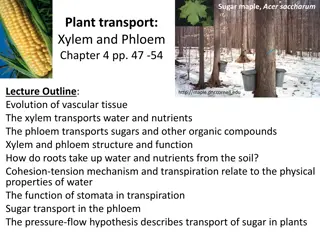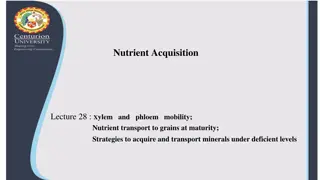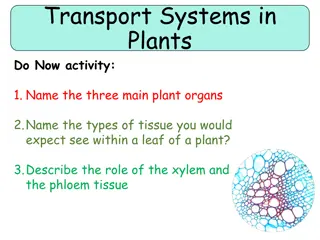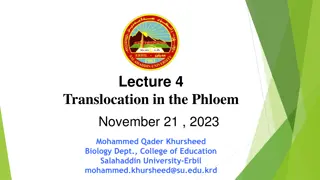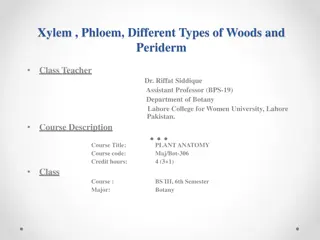Transport in the Phloem: A Detailed Overview by Ashish Sharma, Ph.D.
The phloem plays a vital role in transporting sugars and organic materials throughout plants. This system involves various specialized cells like sieve elements, companion cells, parenchyma cells, and phloem fibers. Mature sieve elements lack certain organelles and have non-lignified cell walls, making them efficient for translocation. Phloem is rich in P-proteins, which function in sealing damaged sieve elements. Callose, a -1,3-glucan, is synthesized in response to stresses and aids in the recovery of damaged sieve elements. Each sieve tube element is linked to companion cells through plasmodesmata, ensuring a ready exchange of solutes.
Download Presentation

Please find below an Image/Link to download the presentation.
The content on the website is provided AS IS for your information and personal use only. It may not be sold, licensed, or shared on other websites without obtaining consent from the author. Download presentation by click this link. If you encounter any issues during the download, it is possible that the publisher has removed the file from their server.
E N D
Presentation Transcript
TRANSPORT IN THE PHLOEM Delivered by Ashish Sharma, Ph.D.
INTRODUCTION Roots absorb water and minerals which are transported to shoot and leaves. Leaves exchange gases and photosynthesize. A two way transport system exists between the two components of the plants. One which carries water from roots to shoots and one which carries food from leaves to roots.
The cells of the phloem that conduct sugars and other organic materials throughout the plant are called sieve elements. Sieve tubes, Companion cells, Parenchyma cells, and Phloem fibers
Mature sieve elements are living cells highly specialized for translocation. They lack nuclei, tonoplast, microfilaments, microtubules, golgi bodies and ribosomes. Organelles which are present are mitochondria, plastids and smooth ER. Their cell walls are non-lignified.
Phloem is rich in P-proteins. P-protein is found in all dicots and in many monocots, and it is absent in gymnosperms. It may be tubular, fibrillar, granular, and crystalline. P-protein appears to function in sealing off damaged sieve elements by plugging up the sieve plate pores. A more permanent solution to the problem of sieve pores is deposition of callose plugs.
Callose, a -1,3-glucan, is synthesized by an enzyme in the plasma membrane and is deposited between the plasma membrane and the cell wall. Callose is synthesized in functioning sieve elements in response to damage and other stresses, such as mechanical stimulation and high temperatures, or in preparation for normal developmental events, such as dormancy. The deposition of wound callose in the sieve pores efficiently seals off damaged sieve elements from surrounding intact tissue. As the sieve elements recover from damage, the callose disappears from these pores.
Each sieve tube element is associated with one or more companion cells. The division of a single mother cell forms the sieve tube element and the companion cell. Numerous plasmodesmata penetrate the walls between sieve tube elements and their companion cells, suggesting a close functional relationship and a ready exchange of solutes between the two cells. The plasmodesmata are often complex and branched on the companion cell side.
Companion cells play a role in the transport of photosynthetic products from producing cells in mature leaves to the sieve elements in the minor (small) veins of the leaf. They are also thought to take over some of the critical metabolic functions, such as protein synthesis. Companion cells also help in supplying energy to the sieve cells.
There are at least three different types of companion cells in the minor veins of mature, exporting leaves: ordinary companion cells, transfer cells, and Intermediary cells. All three cell types have dense cytoplasm and abundant mitochondria.
Ordinary companion cells have chloroplasts with well-developed thylakoids and a cell wall with a smooth inner surface. Of most significance, relatively few plasmodesmata connect this type of companion cell to any of the surrounding cells except its own sieve element. As a result, the symplast of the sieve element and its companion cell is relatively, symplastically isolated from that of surrounding cells. if not entirely,
Transfer companion cells, except for the development of finger like wall ingrowths, particularly on the cell walls that face away from the sieve element. cells are similar to ordinary These wall ingrowths greatly increase the surface area of the plasma membrane, thus increasing the potential for solute transfer across the membrane.
Intermediary cells appear well suited for taking up solutes via cytoplasmic connections. Intermediary cells have numerous plasmodesmata connecting them to surrounding cells, particularly to the bundle sheath cells. Although the presence of many plasmodesmatal connections to surrounding cells is their most characteristic feature, intermediary cells are also distinctive in having numerous small vacuoles, as well as poorly developed thylakoids and a lack of starch grains in the chloroplasts.
PATTERNS OF TRANSLOCATION: SOURCE TO SINK Sap in the phloem is not translocated exclusively in either an upward or a downward direction. Sources include any exporting organs, typically mature leaves. Sinks include any non photosynthetic organs of the plant and organs that do not produce enough photosynthetic products to support their own growth or storage needs.
SOURCE-SINK RELATIONSHIP The following generalizations can be made for transport of materials from source to sink: Proximity. The proximity of the source to the sink is a significant factor. Development. The importance of various sinks may shift during plant development. Vascular connections. Source leaves preferentially supply sinks with which they have direct vascular connections. Modification of translocation pathways.
Table: Typical composition of a phloem sap transported in plant of castor bean.
PHLOEM LOADING Several transport steps are involved in the movement of photosynthate from the mesophyll chloroplasts to the sieve elements of mature leaves, which is called phloem loading. Triose phosphate formed by photosynthesis during the day is transported from the chloroplast to the cytosol, where it is converted to sucrose.
Sucrose moves from the mesophyll cell to the vicinity of the sieve elements in the smallest veins of the leaf. This short-distance transport pathway usually covers a distance of only two or three cell diameters. In a process called sieve element loading, sugars are transported into the sieve elements and companion cells.
Photosynthates can move via apoplast or symplast Sugars might move entirely through the symplast (cytoplasm) via the plasmodesmata, or they might enter the apoplast at some point en route to the phloem. Phloem loading through the symplast is through plasmodesmata following bulk flow while through apoplast it is an energy driven pathway.
THE MECHANISM OF TRANSLOCATION IN THE PHLOEM: THE PRESSURE FLOW MODEL In early research on phloem translocation, both active and passive mechanisms were considered. All theories, both active and passive, assume an energy requirement in both sources and sinks. In sources, energy is necessary to move photosynthate from producing cells into the sieve elements. In sinks, energy is essential for some aspects of movement from sieve elements to sink cells, which store or metabolize the sugar.
Diffusion is far too slow to account for the velocities of solute movement observed in the phloem. Translocation velocities average 1 m h 1; the rate of diffusion is 1 m per 32 years! The pressure-flow model, first proposed by Ernst M nch in 1930, states that a flow of solution in the sieve elements is driven by an osmotically generated pressure gradient between source and sink The pressure gradient is established as a consequence of phloem loading at the source and phloem unloading at the sink.
In source tissues, energy-driven phloem loading leads to an accumulation of sugars in the sieve elements, generating a low (negative) solute potential ( s) and causing a steep drop in the water potential ( w). In response to the water potential gradient, water enters the sieve elements and causes the turgor pressure ( p) to increase.
At the receiving end of the translocation pathway, phloem unloading leads to a lower sugar concentration in the sieve elements, generating a higher (more positive) solute potential in the sieve elements of sink tissues. As the water potential of the phloem rises above that of the xylem, water tends to leave the phloem in response to the water potential gradient, causing a decrease in turgor pressure in the sieve elements of the sink.
SYNTHESIS OF STARCH AND SUCROSE Starch is synthesized in chloroplast and sucrose in cytosol. Depending upon the requirement by the plant starch or sucrose can be synthesized. For storage starch For transport sucrose.


